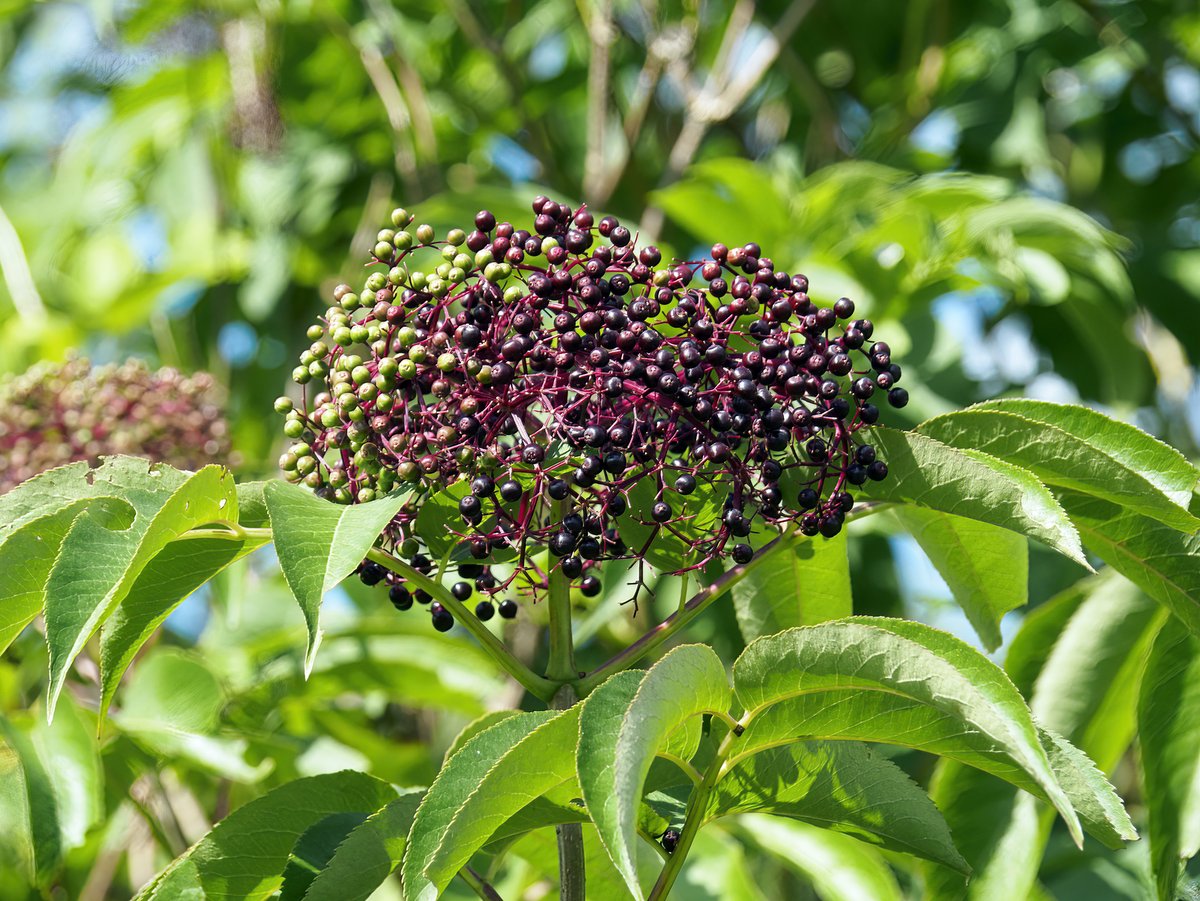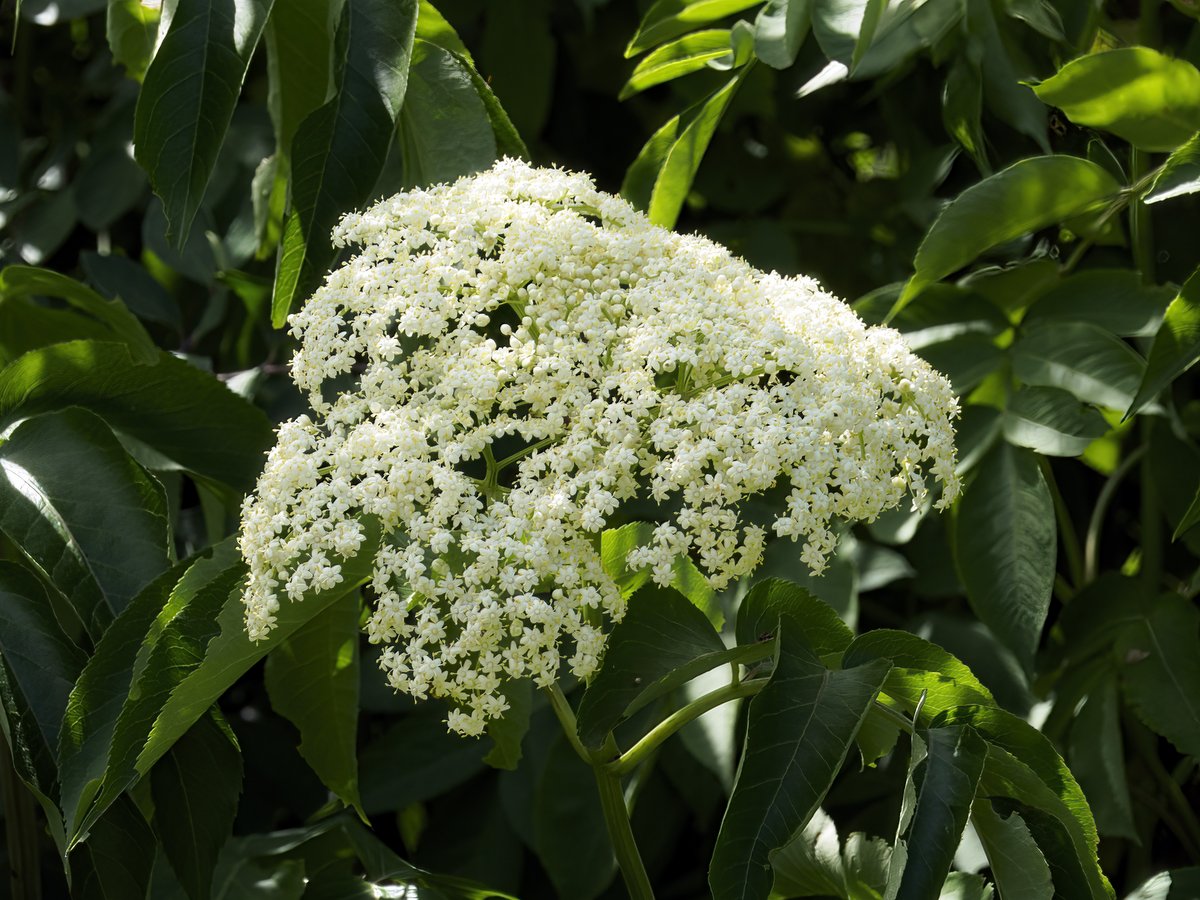Sambocade: Take and make a crust in a dish and take curds and wring out the whey and draw them through a strainer and put in the crust. Add a third part of sugar and some egg whites and shake in elderflowers and bake it up with rose water and serve it up.
So reads a recipe, written in 1390, for an elderflower cheese tart. (It is apparently delicious: see https://blogs.bl.uk/digitisedmanuscripts/2020/09/great-medieval-bake-off.html). A Renaissance recipe for elderflower fritters sounds interesting, though a Roman elderberry custard might not please modern tastes. All of these dishes were made with the blossoms and fruit of Sambucus nigra ssp. nigra, the European elder, which grows abundantly on that continent. When Europeans came to North America, many trees were foreign to them, but they recognized S. nigra ssp. canadensis, the American black elder, which is shrubbier but otherwise very similar to the European species. (Neither should be confused with box elder, an unrelated tree whose pinnately compound leaves resemble those of the elder.) Early colonists made American elderberries into wine and cough syrup.

Photo: Charles R. Smith
Although these dainty dishes mostly graced aristocratic tables, do not assume that the elder is a frivolous tree. It was sacred to pre-Christian Europeans and more recently was associated with beings of great power, generally feminine, who were helpful if honored, dangerous if disrespected. But why would it have such authority? Neither S. nigra nor canadensis grows much taller than twenty feet or lives much longer than a half-century; their small trunks do not provide wood that is either particularly beautiful or useful. (The word “elder” has nothing to do with age, but seems to be related to the Anglo-Saxon word for “fire.” The small branches, cleared of pith, can be used to make bellows, or indeed anything that uses a hollow tube; the genus name, Sambucus, comes from a Greek word for “flute.” It is notable that the tree has never been named for its showy clusters of blossoms or berries, but always for the hollowness of its stems.) Paints and dyes can be made from the elder, but it is hardly unique: many other forest plants can be used in the same way.
If the oak was revered because it was the giant of the European old-growth forest, then the elder may have been deified for precisely the opposite reason. It grows and dies within the lifespan of a human being, recovers quickly when browsed or cut back, and spreads quickly by suckering. Because it is immune to lightning strikes (likely because it is short) and grows in disturbed areas, it was considered to be protective and planted around households and farms. Branches, placed around doors and windows, kept out witches and thieves. Elder leaves do indeed ward off flies, if not necessarily evil spirits, since they smell like (some would say) cat urine and contain a natural insect repellant.

Photo: Charles R. Smith
The tiny, creamy-white blossoms, on the other hand, are as fragrant as the leaves are pungent. Their sweet yellow-green scent, designed to attract a range of pollinators, can be used for cooking, teas, perfumes, and cosmetics, or to make a delicate wine. According to some reports, this wine was consumed in ancient ritual contexts in order to invoke clairvoyance. This is probably not just legend: although the blossoms are apparently safe for consumption, the leaves, stems, roots, seeds, and unripe fruit contain a healthy amount of cyanide, which, in excessive quantities, can induce seizures and hallucinations, among other symptoms. (Fans of historical recipes need not worry: cyanide is deactivated by heating or fermentation.) Nevertheless, many birds and mammals eat the berries and browse the foliage with apparently no ill effect.
The elder produces chemicals, including cyanide, to deter various insects and parasites. Many of these compounds also have medicinal uses. The tree thus contains not only poisons and insectifuges but a veritable pharmacopeia of remedies, including purgatives, analgesics, antipyretics, laxatives, and antidiarrheals.
If you happen to see black-purple elderberries among scarlet and honey leaves – the elder is quite beautiful in autumn – you might ask for the protection of this contradictory forest spirit, close cousin to a European dryad: tree of paradoxes, of vengeance and protection, poison and medicine, death and rebirth.

